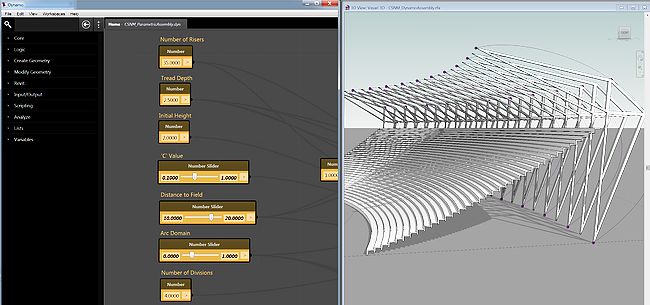
A screenshot of the Dynamo interface running inside Revit.
Over the past few years developers of software for the architecture, engineering, and construction industries have called into question the role of the desktop computer in design. They have either produced software that exploits the desktop’s computational power or have abandoned it as a design tool entirely. This marks a significant change in focus—from software that facilitates the production of digital versions of traditional architectural documentation to the expansion of design capabilities through advanced computational modeling or desktop-free design production reliant on mobile devices and cloud computing. Recognizing this trend, Autodesk showcased two programs—Formit and Dynamo—late last month at the AIA National convention in Denver.
Formit, an iPad application, allows designers to create basic conceptual forms and upload them to Autodesk’s building information modeling (BIM) platform, Revit, turning the mobile device into a design tool. Formit also opens existing Revit files through the Autodesk 360 cloud service, offering some of the visualization capabilities ArchiCAD users enjoy with Graphisoft’s BIMx app.
Dynamo is Autodesk’s first foray into visual scripting and given the company’s reach in the world of design and construction, the software has the potential to make computational design methods accessible to a broad base of architects. Dynamo is a plugin for the latest versions of Revit and Vasari—a conceptual design program that Autodesk has been beta testing since 2010. Dynamo allows designers to script operations, using a graphical interface. Dynamo “reveals capabilities in Revit, making them more accessible visually,” says Zach Kron, Autodesk’s principal design strategist.
Compared to generating digital models manually, Dynamo gives designers “the ability to design with more complex variation and iteration,” says Danelle Briscoe, an assistant professor of architecture at the University of Texas, in Austin. Aside from teaching both Revit and Dynamo, Briscoe is using the latter tool’s algorithmic capabilities to develop a complex green facade system for a university parking garage.
Though Dynamo has been in beta-testing for over two years, in the last six months Autodesk has ramped up its development and promotion. Rather than issuing yearly releases, Dynamo, which is open source, will be in perpetual beta-mode as the company makes adjustments in response to user feedback. Dynamo, Formit, and Vasari are all currently available for free from Autodesk.


Post a comment to this article
Report Abusive Comment